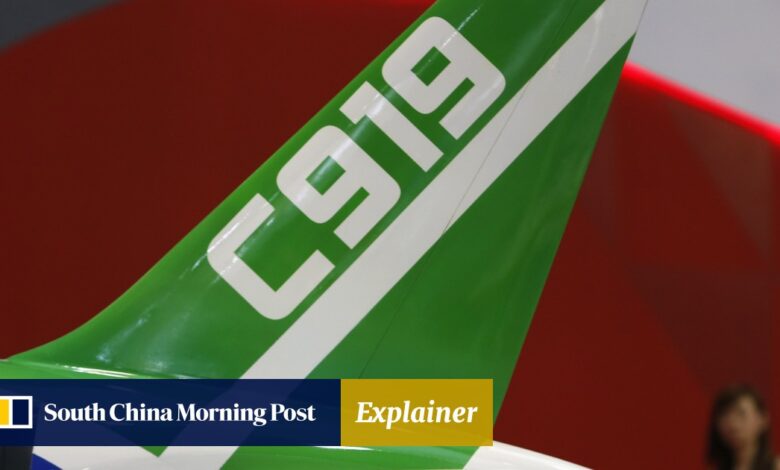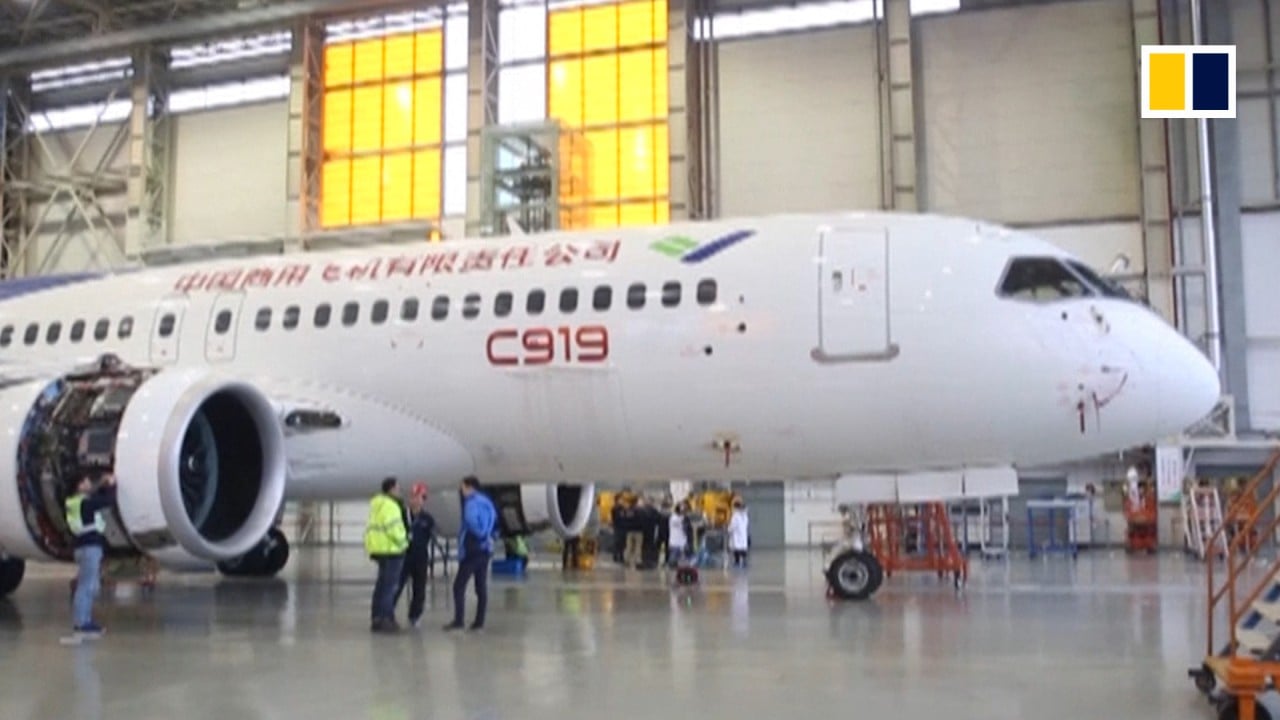C919: what is China’s home-grown alternative to Airbus, Boeing duopoly, and why is it important?

However, most of the parts are imported from foreign manufacturers, including the engine, avionics, control systems, communications and landing gear.
Nearly one-third are from Europe, while there are 14 Chinese suppliers, with seven of those being joint ventures with foreign firms.
General Electric also formed a joint venture with the state-owned Aviation Industry Corporation of China (AVIC) in 2012 to focus on avionics development for the C919.
Why is the C919 important to China?
China is among the world’s fastest-growing civil-aviation markets, and the C919 is the nation’s ambitious attempt to manufacture its first commercial jetliner to meet its own rising demand.
The success of the project would be economically beneficial for China, as it could break the country’s dependence on the duopoly currently enjoyed by Boeing and Airbus, and has the potential to catapult Comac into the multibillion-dollar aviation industry.

01:07
Three more Chinese C919 passenger jets to start test flights by late 2019
Three more Chinese C919 passenger jets to start test flights by late 2019
The plane’s development was an integral element of the “Made in China 2025” plan, a road map from 2018 that Beijing hoped would help lift its hi-tech industries to international levels.
The C919 was also mentioned by President Xi Jinping in his report at the 19th National Congress in 2017, along with the nation’s other scientific achievements, as drivers of China’s “new model of development”.
How does the US-China relationship impact the development of the C919?
While China has been among the biggest buyers of US aviation products, its state-driven investment in aviation, which has included buying US aerospace companies, has set off alarm bells in Washington.
Beijing’s national strategy of “military-civil fusion”, a policy that aims to use civil technology to strengthen its military capacity and development, is also a concern for the US.

The report, compiled by the Rand Corporation, found that China’s total investment in US aerospace companies over the past decade was relatively small and involved low-end technology.
There were some concerns over technology transfers through joint ventures connected with the C919 project, but the report also cited experts saying that the risk was low because of US export-control restrictions.
Aerospace products are valuable exports for the US economy and integral to its national security. Many aviation products fall under US export-controls restrictions, including the CFM International LEAP, or Leading Edge Aviation Propulsion, engine produced in a joint venture between General Electric and Safran that is used on the C919.

00:52
China, Russia unveil model of joint venture passenger plane at Zhuhai Airshow
China, Russia unveil model of joint venture passenger plane at Zhuhai Airshow
China’s investment in US aviation companies is also subject to review and approval by the Committee on Foreign Investment in the United States. The committee is an inter-agency group of the US government that reviews the national security implications of foreign investments in US companies or operations.
But as relations between Beijing and Washington have soured, the US government has tightened its regulations over the sales of aviation products to China, potentially adding hurdles to the development of the C919.
While Comac is not on the list, seven entities related to AVIC, which holds a minority share of Comac, were included.
On January 14, 2021, the US Department of Defence added nine Chinese companies, including Comac, to its list of “Communist Chinese military companies”.
Under an earlier executive order signed last year by then president Donald Trump, American investors were prohibited from certain transactions in securities related to certain listed companies. Comac is not a publicly traded company, but it has sold bonds in the Chinese securities market.
The Pentagon said in a statement that it is “determined to highlight and counter the People’s Republic of China’s (PRC) Military-Civil Fusion development strategy, which supports the modernisation goals of the People’s Liberation Army (PLA) by ensuring its access to advanced technologies and expertise acquired and developed by even those PRC companies, universities, and research programs that appear to be civilian entities”.
Earlier in 2020, the US government was weighing whether to deny General Electric’s request to provide the LEAP engines for the C919. It eventually approved the licence for the jet-engine sales after President Donald Trump said the US should not prevent companies from supplying jet engines and other components to China.
What is the outlook for the C919?
The C919 made its maiden test flight in 2017, but has yet to be certified.
Its chief designer, Wu Guanghui, told Chinese media in November 2020 that the narrow-body jetliner was aiming to receive a type certification by the end of 2021 after the airline regulator, the Civil Aviation Administration of China (CAAC), authorised the C919 to begin the testing process.
Comac said airlines and aircraft-leasing firms have placed orders for 1,065 C919s, with the vast majority of demand coming from Chinese carriers.
Comac has consistently over-promised on its ability to get through each of these stages, and hence, it is not worth speculating how many more years remain before the first paying customers find their seat for a regular commercial flight
However, some analysts believe it will take some time before the C919 receives certification from the CAAC, and even longer to receive certification by US and European aviation regulators before China is able to sell the C919 in these large foreign markets.
“Comac has consistently over-promised on its ability to get through each of these stages, and hence, it is not worth speculating how many more years remain before the first paying customers find their seat for a regular commercial flight,” said Scott Kennedy, a senior CSIS adviser who is responsible for research into Comac.
Kennedy estimated in December 2020 that Comac had already received between US$49 billion and US$72.1 billion from the Chinese government for the C919.
And it appears unlikely that China will stop channelling state money into the C919.
In 2016, Beijing set up the Aero Engine Corporation of China to build an indigenous engine for the C919, the CJ-1000AX, in the hope that it could eventually replace the LEAP engine produced by General Electric and Safran.
Under Xi’s so-called dual-circulation strategy, which focuses on home-grown innovation to counter external hostility, China is accelerating its technology development and investment.
Liu Daxiang, deputy director of the science and technology committee at AVIC, said in December 2020 that producing a jet engine was an urgent political task, but conceded that its production would take a long time because China lacks research, experience and data.
Source link

